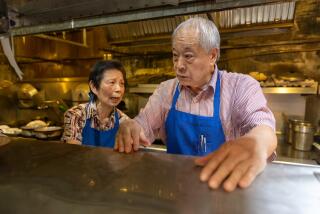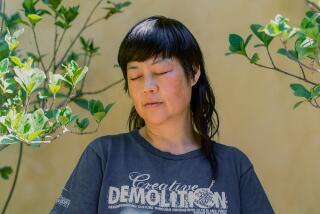Seeking Out History’s Hidden Stories
“M o gong, mo gong ,” her mother would say in Cantonese when the children asked why the older three of them were surnamed Gee and the younger four Wong. “Don’t talk about it, don’t talk about it.” This was how artist Flo Oy Wong grew up in Oakland, in the shadow of a silenced bit of family history.
Little by little, however, the secret unraveled. “We solved pieces of the puzzle ourselves,” says Wong, sitting in a gallery at the Japanese American National Museum, where four of her artworks are being installed. Two of them address that shadowy history.
It turns out that when her mother, Theo Quee Gee, entered the United States in 1933, via Angel Island in the San Francisco Bay, she posed as the sister of her husband. It was a way around the Chinese Exclusion Law of 1882, which prohibited Chinese laborers and their families from entering the country, although immediate family members of those already in the country could do so.
The secret got more complicated. When Gee, still posing as her husband’s sister, found herself pregnant, she quickly married another man to give the baby (and the ones that followed) legitimacy, though she continued to live with her first husband and her first three children.
“Flo Oy Wong: Angel Island, Immigration and Family Stories,” which opened Saturday, is the award-winning artist’s first major show in Southern California. Using materials that include rice sacks and vintage suitcases, and techniques that include silk-screening and embroidery, Wong retells the story of her family through her multimedia pieces.
During the process, which involves research and interviews with relatives and friends, she has discovered quite a few things about herself. “My art is very revelatory to me,” Wong says. “I just jump in and use whatever emotions come to me, and I find a lot of the knowledge I buried myself.”
Although Wong, 62, is Chinese American, the museum was enthusiastic about including her on its exhibition schedule. “I was really struck by the idea of Flo as an artist being a catalyst within her community,” says Kristine Kim, the museum’s associate curator and organizer of the show, “getting people to open up and talk about things that had been hidden and shameful.
“We also saw a parallel between the Chinese Americans coming to terms with this history and the incarceration of Japan Americans during World War II--both were once considered too embarrassing to talk about.”
Born and raised in Oakland, Wong was the sixth of seven children. Three of her sisters were born in China and came into the United States with their mother in 1933. Her other siblings were born in the U.S. “It was very challenging for our family,” Wong says. “The American-born were very, very Western--we eventually became in-your-face. My older sisters were much more reserved.”
By the time she was 5, Wong was already working at the family restaurant, filling sugar jars and wiping silverware. She helped out even through her college days at UC Berkeley, where she majored in English, and stopped only when she got a teaching job and got married in her early 20s.
“My original idea was to teach Shakespeare to high school students,” she says, “but I fell in love with the little ones, so I ended up teaching them.”
When she had her own children, she left teaching to spend time with them. When they were older, she began to take art courses. Wong pegs the beginning of her art career to turning 40--”That’s when I began to get serious about it and wanted to show in galleries and museums.”
While her earliest works were pastels and pencil drawings, she soon found herself drawn to multimedia.
Her well-known rice-sack pieces--six so far--came about partly through happenstance. Brought up in a thrifty Chinese household, it was her habit to save everything that could be reused, so she had plenty of them at home.
At the same time, she recognizes that rice, the staple of the Chinese diet, has profound meaning for the Chinese. “We always had this fixation on rice,” says Wong. “Rice is a physical and spiritual food.”
The exhibition is made up of four parts--”Baby Jack Rice Story,” “made in the usa: Angel Island Shhh,” “My Mother’s Baggage: Paper Sister/Paper Aunt/Paper Wife,” and the first piece in a planned series called “Kindred Spirit,” based on Chinese American scientist Wen Ho Lee.
The rice-bag panels of “Baby Jack Rice” are silk-screened with scenes from Wong’s husband’s childhood in Georgia, including pictures of his two close friends, both black. “My Mother’s Baggage” presents Wong’s mother’s immigration story, from her landing at Angel Island until she was finally granted a green card in 1964. Inside six vintage suitcases, Wong has applied documents, photographs and text--done up ransom-style, with letters cut out from different type.
“Kindred Spirit” is a work in progress, named after the code name the government gave the case of Los Alamos scientist Wen Ho Lee. Lee was imprisoned for nine months, from December 1999 to September 2000, on suspicion of spying for China, then freed when the case against him fell apart.
Rather than reacting directly to the questionable nature of his incarceration, Wong decided to focus on what he missed during those months, especially food. In the first piece, a hanging scroll, the central panel is a piece of cloth that has been dyed light brown in oolong tea--Wong used 278 teabags, the number of days Lee was incarcerated. It’s embroidered with his name and I.D. as a Los Alamos scientist.
The work called “made in the usa,” grew out of the fact that eight years ago, Wong’s husband became a docent at Angel Island. As she learned its history through him, Wong became fascinated by its ties to Chinese American families--between 1910 and 1940, 50,000 Chinese immigrants were detained there before being allowed to enter the United States. She began to conduct a series of interviews, first with family and relatives, then with friends and friends of friends.
These stories eventually became the 25 panels that make up “made in the usa: Angel Island Shhh,” with one dedicated to her mother and three to her three China-born sisters. For each, the artist sewed a rice sack onto an American flag, with the flag creating a kind of frame, and printed a shorthand version of real immigrants’ tales, from Lew Wah Doon in 1908 to Lieu Ngon Kay in 1951, including the secrets they kept to gain entry.
“We just lived in the currency of secrets,” Wong recalls of not just her family, but many others in Oakland’s Chinatown--one family had children with three surnames. “We were always afraid of authority, always afraid of white authority,” Wong says, and the prospect of deportation.
In all of her work, the key is uncovering hidden stories and asserting the Chinese American presence in the U.S.
In reference to the immigrants whose faces peer out from the “made in the usa” and in the pieces that spotlight her mother, Wong speaks of reclaiming the subjects’ “true identities” as well as “presenting their secrets.” In the case of the Lee series, she interprets current events “in a way everyone can relate to.”
“I have the Western outlook of expressing, of getting it out there,” she says. “I’m also very cognizant of visibility and invisibility. For the longest time, our story was not part of the landscape. I thought it’s my job to get some of the stories out.” *
*
“FLO OY WONG: ANGEL ISLAND, IMMIGRATION AND FAMILY STORIES,” Japanese American National Museum, 369 E. 1st St., downtown L.A. Dates: Tuesdays, Wednesdays and Fridays-Sundays, 10 a.m.-5 p.m.; Thursdays, 10 a.m.-8 p.m. Ends March 31. Prices: Included in museum admission: general, $6; seniors, $5; students with ID and children 6 to 17, $3; 5 and younger, free. Phone: (213) 625-0414.
More to Read
The biggest entertainment stories
Get our big stories about Hollywood, film, television, music, arts, culture and more right in your inbox as soon as they publish.
You may occasionally receive promotional content from the Los Angeles Times.










